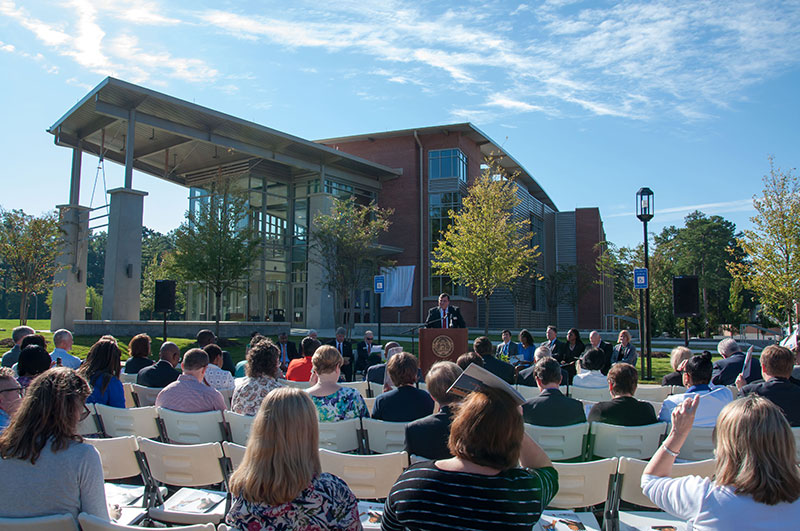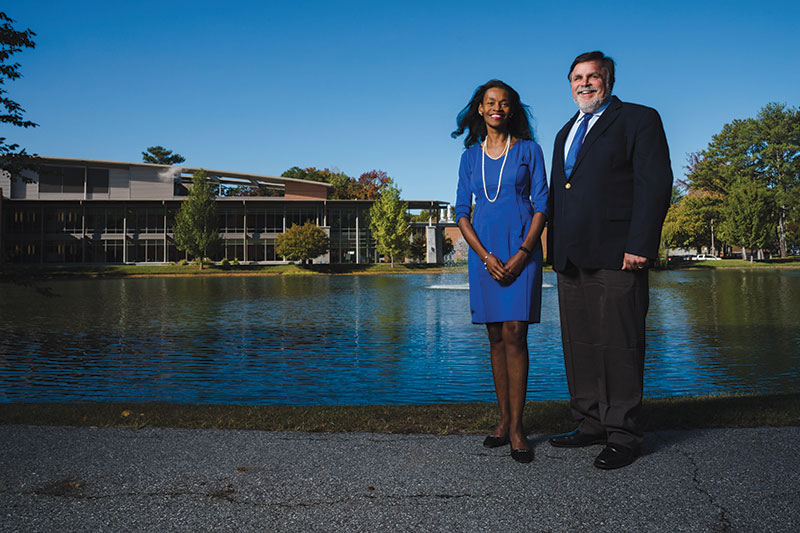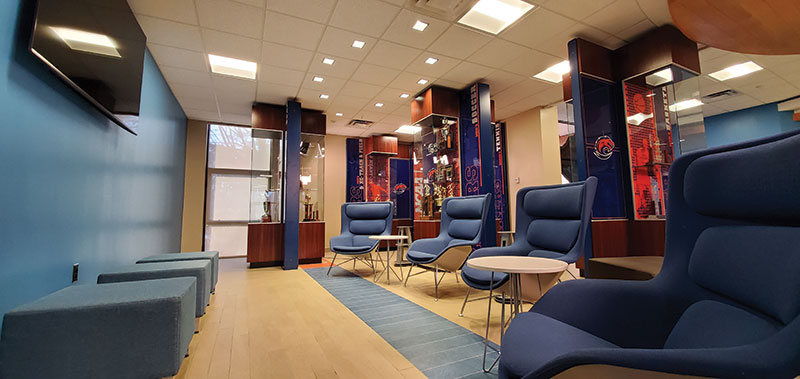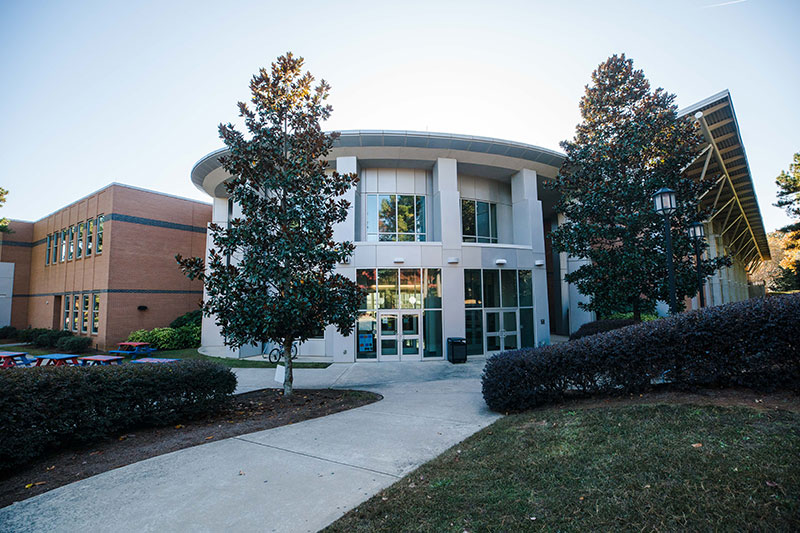On the Move
By Allison Salerno
At 22, Clayton Carte already is making a name for himself in local politics.

Share the Story on FacebookShare the Story on TwitterShare the Story via EmailShare the Story on LinkedIn
Winter 2020 | By Adina Solomon
The sun sparkles off of Swan Lake as students mill around the James M. Baker University Center. Two students approaching from opposite directions recognize each other and say hello outside the doors. Inside the building bustles with people talking and walking. Just a few steps outside Dr. Tim Hynes’ office, students ignore the hum of conversation and sit perched in chairs to study.

Hynes: The place to start in talking about our vision and our mission is our belief that a university’s core business is learning. The usual understanding of that learning is the learning of student, but faculty and staff must continuously participate in the learning process so the learning experiences for our students can accommodate a changing external environment.
As Clayton State University moves into the future, figuring out how to deal with changes in learning methods and student needs, Hynes believes the university will continue to witness scenes such as this one
“There are some futurists who like to believe in the demise of the brick- and-mortar university,” says Hynes, president of Clayton State. “I’m not one of those.”
Hynes sits in a small conference room near his office, a poster of Clayton State’s campus hanging on the wall.
The first 50 years of Clayton State’s existence have spurred growth—in buildings, in number of students, in academic programs. But we’re not here to talk about the past. Instead, Hynes talks excitedly about the future.
Now that Clayton State has reached its 50th anniversary, university and community leaders evaluate how Clayton State’s campus, students, academics and effects on south metro Atlanta will evolve over the next half century.
The student body, which had just under 7,000 people in fall 2019, will multiply, says Corlis Cummings, vice president of business and operations. So will the number of faculty and staff to serve those students.
The makeup of the students could change, too. Clayton State already has an older population, with an average age of 25.6 years old in fall 2019. The numbers of those non- traditional students will continue to rise, says Kevin Demmitt, provost and vice president for academic affairs. Graduate education has become more common. Clayton State’s fastest growing school is the School of Graduate Studies.
“A lot of people are seeing the need to come back and continue their education in order to advance with their careers or to enter a new career,” Demmitt says.
Not only that, but the student body will become even more diverse. In the fall 2019 semester, the enrollment was 62.5% Black, 17.1% white, 8% Latino and 6.8% Asian. But going forward, Clayton State will reflect the local community’s thriving Asian and Latino populations.
“Our service proposition—to try and convince an amazingly diverse population that they belong in education—will be a harbinger of what other institutions will be required to do,” Hynes says. That increasing diversity will require Clayton State to ponder inclusiveness, embracing and exploring differences in order to bring the campus community closer together, says J. Celeste Walley-Jean, associate professor of psychology and dean of Graduate Studies and Inclusive Engagement.
“We’re a diverse institution by accident,” Walley-Jean says.
As Clayton County has become more diverse over the years, so the university has followed. In 1990, the county’s population was under 24% Black. By 2018, it had tripled to 72%. This goes beyond ethnic and racial diversity, also encompassing diversity in age.
“I would love to see [that] rather than having these things happen kind of passively, for us to really focus and be intentional about creating the environment that we want to see,” Walley-Jean says.

This could include increasing programming around inclusiveness. The increase in students over the next 50 years will have physical effects on Clayton State. Today, the main campus in Morrow stretches across 214 acres. But more students will require more space, Cummings says. Think more classroom buildings and greenspace for intramural fields. Shared community spaces, such as a convocation center that can host sports games, graduations and other events. Perhaps Clayton State will need another student center for club meetings and activities.
A projected surge in traditional students, typically ranging in age from 18 to 22 years old, could lead to more people looking to live on campus. That means a need exists for more housing, Cummings says. Clayton State has no family housing now for older and graduate students, so the university could also build that.
As for where this space will come from, Cummings says the university can acquire property from neighbors and build on parking lots, replacing them with parking decks. As for what goes inside these buildings, forget the traditional classroom with chairs facing the front of the room for a lecture. Demmitt says Clayton State could build more flexible workspaces, complete with chairs that students can move when they need to interact with each other.
How students learn in those classrooms will also morph. A traditional college major focuses on a single idea, but the world will require a more broadly educated student, Demmitt says.
Clayton State is looking to adapt its curricula to this type of education.
And a bachelor’s degree will not mark the end of a person’s education. Demmitt says as people move through their careers or transition to a new career or position, they need to develop new skills. So, it will become more common for them to turn to continuing education to fill that gap, especially as more older students come to Clayton State.
“We often talked about lifelong learning, but we have not had much of a platform to actually promote or encourage that,” Demmitt says.
Clayton State wants people to come to them for that education.
To that end, the university is looking at micro-credentials, a mini certification for specific skills, in competencies that employers look for: data analytics, IT, critical thinking, the ability to work with people across cultures. It will serve as a way for people to document what they learned or accomplished, Demmitt says.

While an academic degree program typically takes longer to develop and requires multiple approvals from state and national agencies, continuing education is a rapid response to immediate workforce needs. It can also be shorter term, spanning weekends or a week.
To see how continue education can work, take the case of entertainment. Georgia’s once- nascent film industry began to take off in 2008 due to a tax credit for projects that shoot in the state. By 2017, the state was the top shooting location in the country for the highest-grossing U.S. movies. Film and TV production now supports 92,000 jobs in Georgia.
As the film industry took off, Clayton State was among the first to offer a film production program. It launched that through the Center for Continuing and Professional Education.
Demmitt says the university got the program up and running in a matter of months. Clayton State now has a 10,000-square-foot film studio in Jonesboro, seven miles south of the main campus.
The film program itself is expected to expand, concentrating in post-production. Demmitt calls it the next employment wave in the state’s entertainment industry.
“Not only will the films be shot here, but they’ll also be edited and finished in Georgia as well,” he says.
Continuing education is not the only avenue that Clayton State will pursue. Online learning will also evolve. In fall 2012, under a quarter of all postsecondary students in the U.S. studied online. In 2017, about a third took at least one online course.
Non-traditional students often need the flexibility of online classes, so that’s where a lot of growth in that area has centered, Demmitt says. But many people prefer a combination of online classes and access to study groups, tutorials and professors.
“I see us increasingly finding ways to offer the convenience of online but offer the impact that comes from face-to-face interactions,” Demmitt says, whose background is in sociology. “There is a special dynamic that comes from actually interacting with a person face to face that I think increases understanding of how others view the world. And I believe that a central part of a college education is learning to see the world from multiple perspectives.”
At the same time, people can find it hard to come to Clayton State’s main campus while dealing with work and family demands and traffic. In the future, the university could place smaller centers throughout metro Atlanta where people can meet other students and hold study groups.
“It gives them a sense of contact with the university, even if they cannot make it to campus,” Demmitt says.
But online learning will still play a large role. Demmitt wants Clayton State to offer more resources to support students, especially keeping in mind those who balance work and family demands. Resources could include watching classes on video and meeting with study groups online.
Someday, it could become routine to connect with students and faculty throughout the day on different types of media, he says.
Clayton State’s reach goes further than the confines of its main campus in Clayton County. It has extensions throughout south metro Atlanta in Henry and Fayette counties—areas that are ripe for change in the coming years. The total population of Clayton, Fayette and Henry counties in 2015 was about 596,000. By 2050, it is projected to jump by around 52% to just over 900,000 people, according to Atlanta Regional Commission numbers.
With that population boom will likely come more businesses and development, requiring the knowledge and guidance of Clayton State.
“What the relationship [with neighboring communities] will be is unclear, but that there will be a relationship I think is essential to the identity of this institution,” President Hynes says. “We’ve been incredibly intentional in trying to find ways to serve our community... Exactly what talents will be needed, what workforce needs there will be, what the nature of the community, the south metro Atlanta environment will be, my fondest hope is that the university will adapt and, in many instances, take the lead in pushing forward those changes to support that community.”
Clayton State can work with its neighbors by providing expertise in conversations of the future, Cummings says. Budding entrepreneurs now come to the Small Business Development Center, part of the University of Georgia but on Clayton State’s campus in Morrow, for free consulting services and low-cost educational programs. Cummings says capacity exists to increase Clayton State’s entrepreneurship services, perhaps with incubators that provide physical space for people to come receive advice and start their business.
In addition, people in the community could use the university’s faculty and expertise. “I would anticipate that as there are either problems that needed to be solved or strategic plans or visions that needed to be discussed and implemented that we would always definitely be at that table to help guide and participate,” Cummings says. “We have to be good neighbors and good stewards. The Southern Crescent region is our backyard, so we want to be a part of its growth and make sure that this is successful.”
One of the impending challenges to success that the region faces? Getting around that backyard. Over the next 50 years, south metro Atlanta will need to rethink mobility beyond traditional cars, says Gerald McDowell, executive director of the Aerotropolis Atlanta Community Improvement Districts around Hartsfield-Jackson Atlanta International Airport.

McDowell believes that Clayton State could become a leader in south metro Atlanta’s mobility dialogue by directing students to explore new modes of transportation for surrounding communities.
“It’s very similar to how film and television started exploding in Georgia and then the university started offering opportunities for students to participate in that industry,” McDowell says.
As it becomes more commonplace in our everyday lives, autonomous and connected technology will shape how people move. “All that autonomous technology is going to be in our community over the next 50 years, and so we need to recreate and rethink our road networks and our interstate system,” he says.
Clayton State could create opportunities for students to research and provide leadership on how to accommodate these innovations, similar to how the Aerotropolis now works with the Georgia Institute of Technology.
Clayton State could even have a center of excellence for mobility, housing a research or demonstration lab to show off new technologies and partner with the private sector.
As more and more people live in south metro Atlanta, building out transit is crucial. By 2050, Clayton’s population will swell by 44% over 2015. Fayette will spike by 33%, while Henry will have one of the highest growth rates in metro Atlanta at 70%, according to the Atlanta Regional Commission.
A car-centric system will make moving around all those people difficult. McDowell says Clayton State could develop opportunities for students to explore how south metro can build in a healthy way that will integrate anticipated expansion and development.
That development will include new businesses opening up. The top issue that they face is recruiting a well-trained workforce, says Colin Martin, president and CEO of the Fayette Chamber of Commerce. He says Clayton State is in a position to help fill those needs into the future.
“Clayton State could become the single most important economic driver for our region,” Martin says.
Hartsfield-Jackson Atlanta International Airport stands in Clayton State’s backyard, forming a strong aerospace industry.
Advance manufacturing and engineering will also continue to expand, he says. In addition to business, Clayton State could cultivate prospective county leaders who will help decide the trajectory of the region, says Shannon James, president and CEO of the Aerotropolis Atlanta Alliance.
He expects the university can create a talent pipeline for future employer needs and at the same time serve as research center to find the solutions that will make the south metro Atlanta region economically competitive.
“I think the university is going to play a critical role as a resource engine to provide recommendations for solutions to help solve some of the challenges that exist within the municipalities of Clayton County and within the county itself,” he says. “Clayton State has the opportunity to serve as a thought leader for some of the county’s challenges and strengths.”
Clayton State already sends their students out into the community to use their existing skills and develop others. Right now, the university runs Partnering Academics and Community Engagement, where students work with community groups on projects that apply what they learn in class.
For example, paralegal students could go to a senior residential facility to help people prepare their wills.
Demmitt says Clayton State wants to further build that program.
“Students are going out, finding out the relevance of what it is that they are learning and also identifying gaps in their education that, when they come back to the classroom, they’re more anxious and ready to fill,” he says.
Students are not the only ones going out into the community, though. In the coming years, the university could grow its instructional sites in Fayette County’s Peachtree City and Henry County’s McDonough, Demmitt says.
Martin says the Fayette Chamber has talked about the need for a permanent Clayton State campus in Fayette. No university has a permanent campus in the county.
“A permanent campus for Clayton State would bring a younger demographic here and could be a center point for arts, entertainment and culture in the county,” he says, pointing to the revitalization that happened in downtown Columbus after Columbus State University opened a riverside campus there.
So much has happened at Clayton State in its first five decades. A campus in Morrow of more than a dozen buildings on six lakes sprung up. Thousands of students—not to mention faculty and staff—have walked the halls of the university. Instructional sites arrived in Henry and Fayette counties.
Even the past 14 years have seen a lot. When Walley-Jean arrived at the university in 2006, it didn’t even have a dorm. Clayton State will need to respond to and help guide tremendous change in the next 50 years, both inside and outside of its walls.
“I am impressed and optimistic about our future because we’ve done so much in a very short period of time,” Walley-Jean says. “Having a relatively stable institution puts us in a good position to do more and be more than we have been.”
As south metro Atlanta’s communities, transportation and economy evolve, Clayton State has a chance to use its power for the good of the region. It can foster the future.
By Kelly Petty
On the fifth floor of downtown’s hipster hangout, Ponce City Market, is Mailchimp, a leading email marketing platform known as much for its services as its mammalian mascot.
By Allison Salerno
At 22, Clayton Carte already is making a name for himself in local politics.
By Kelly Petty
When a committee of faculty and staff came together in 1994 to create a time capsule containing historical items from the school’s 25 years since its inception . . .
By Adina Solomon
When you move you consume oxygen. When you move fast, your heart rate and blood pressure rises. A metabolic cart can help improve the cardiovascular system of heart patients and athletes alike.